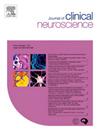未破裂颅内动脉瘤行血管内栓塞患者术前焦虑和抑郁的危险因素
IF 1.8
4区 医学
Q3 CLINICAL NEUROLOGY
引用次数: 0
摘要
目的在治疗颅内未破裂动脉瘤(UIAs)时,神经外科医生主要侧重于评估其破裂风险并选择合适的治疗策略。然而,对患者术前心理状态和心理健康障碍患病率的关注有限。本研究旨在调查因UIAs而计划进行血管内栓塞的患者的术前焦虑和抑郁水平,并确定导致这些情况的潜在危险因素。方法共纳入121例诊断为UIAs并计划于2021年1月至2023年6月进行栓塞治疗的患者。术前评估采用医院焦虑和抑郁量表(HADS),系统记录人口统计学和临床数据,以及焦虑和抑郁评分。单因素分析采用卡方检验和t检验,构建logistic回归模型,确定术前焦虑和抑郁相关的独立危险因素。结果121名参与者中,42名(34.7%)表现为边缘性焦虑或临床焦虑,40名(33.1%)表现为边缘性抑郁或临床抑郁。Logistic回归分析发现,年龄(OR: 0.945, 95% CI: 0.906 ~ 0.986, P = 0.008)、介入治疗类型(OR: 2.706, 95% CI: 1.124 ~ 6.516, P = 0.026)和术前临床症状(OR: 4.188, 95% CI: 1.78 ~ 9.852, P = 0.001)是影响HADS-A显著异常的独立危险因素。对于术前抑郁,较高的身体质量指数(BMI) (OR: 1.256, 95% CI: 1.042-1.515, P = 0.017)、术前临床症状(OR: 3.597, 95% CI: 1.532-8.444, P = 0.003)和ASA分级(OR: 1.897, 95% CI: 1.113-3.233, P = 0.019)被确定为异常HADS-抑郁(HADS- d)评分的独立预测因子。结论在接受血管内治疗的UIAs患者中,有相当比例的患者术前表现出焦虑和抑郁。术前焦虑的独立危险因素包括年龄、介入治疗类型和术前症状。对于抑郁症,术前症状、BMI和ASA分级是关键因素。这些发现强调了在这类患者群体中进行有针对性的心理评估和支持的重要性。本文章由计算机程序翻译,如有差异,请以英文原文为准。
Risk factors for preoperative anxiety and depression in patients with unruptured intracranial aneurysms scheduled for endovascular embolization
Objective
In managing patients with unruptured intracranial aneurysms (UIAs), neurosurgeons primarily focus on assessing rupture risk and selecting appropriate treatment strategies. However, limited attention has been given to patients’ preoperative psychological status and the prevalence of mental health disorders. This study aims to investigate the levels of preoperative anxiety and depression in patients scheduled for endovascular embolization for UIAs and identify potential risk factors contributing to these conditions.
Methods
A total of 121 patients diagnosed with UIAs and scheduled for embolization between January 2021 and June 2023 were enrolled. Preoperative evaluations were conducted using the Hospital Anxiety and Depression Scale (HADS), with demographic and clinical data, as well as anxiety and depression scores, systematically recorded. Chi-square tests and t-tests were used for univariate analyses, and logistic regression models were constructed to identify independent risk factors associated with preoperative anxiety and depression.
Results
Among the 121 participants, 42 (34.7 %) demonstrated borderline or clinical anxiety, while 40 (33.1 %) exhibited borderline or clinical depression. Logistic regression analysis identified age (OR: 0.945, 95 % CI: 0.906–0.986, P = 0.008), type of interventional therapy (OR: 2.706, 95 % CI: 1.124–6.516, P = 0.026), and preoperative clinical symptoms (OR: 4.188, 95 % CI: 1.780–9.852, P = 0.001) as independent risk factors for significant abnormalities in HADS-Anxiety (HADS-A). For preoperative depression, higher body mass index (BMI) (OR: 1.256, 95 % CI: 1.042–1.515, P = 0.017), preoperative clinical symptoms (OR: 3.597, 95 % CI: 1.532–8.444, P = 0.003), and ASA grade (OR: 1.897, 95 % CI: 1.113–3.233, P = 0.019) were identified as independent predictors of abnormal HADS- Depression (HADS-D) scores.
Conclusions
A substantial proportion of patients with UIAs scheduled for endovascular treatment exhibit preoperative anxiety and depression. Independent risk factors for preoperative anxiety include age, type of interventional therapy, and preoperative symptoms. For depression, preoperative symptoms, BMI, and ASA grade are key contributors. These findings underscore the importance of targeted psychological assessment and support in this patient population.
求助全文
通过发布文献求助,成功后即可免费获取论文全文。
去求助
来源期刊

Journal of Clinical Neuroscience
医学-临床神经学
CiteScore
4.50
自引率
0.00%
发文量
402
审稿时长
40 days
期刊介绍:
This International journal, Journal of Clinical Neuroscience, publishes articles on clinical neurosurgery and neurology and the related neurosciences such as neuro-pathology, neuro-radiology, neuro-ophthalmology and neuro-physiology.
The journal has a broad International perspective, and emphasises the advances occurring in Asia, the Pacific Rim region, Europe and North America. The Journal acts as a focus for publication of major clinical and laboratory research, as well as publishing solicited manuscripts on specific subjects from experts, case reports and other information of interest to clinicians working in the clinical neurosciences.
 求助内容:
求助内容: 应助结果提醒方式:
应助结果提醒方式:


